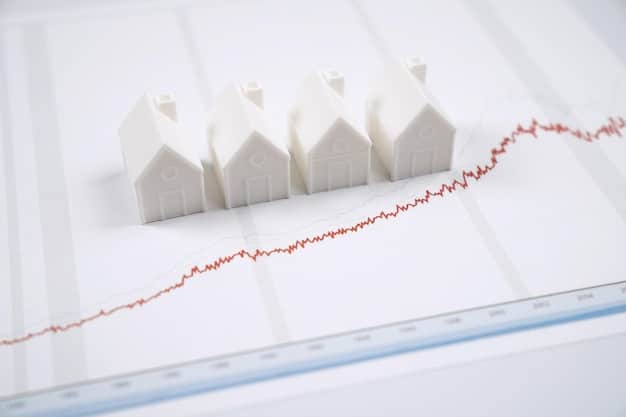Is Refinancing Still Worth It? Mortgage Rates Below 6.7% Analyzed

Analyzing whether refinancing your mortgage remains a beneficial financial move hinges on current interest rates, especially when they dip below 6.7%, considering factors like long-term savings, closing costs, and individual financial goals in the US market.
Considering a mortgage refinance in today’s market? With interest rates fluctuating, many homeowners are asking: is refinancing your mortgage still worth it? Analyzing rates below 6.7% in the current market reveals whether it’s a smart financial move.
Understanding Current Mortgage Rate Trends
To determine if refinancing your mortgage is a good idea, it’s crucial to understand the current landscape of mortgage rates. Keeping an eye on these trends can help you make an informed decision.
Factors Influencing Mortgage Rates
Several factors influence mortgage rates, including economic indicators, inflation, and actions taken by the Federal Reserve. Understanding these can provide insight into potential rate movements.
Economic stability and low inflation often lead to lower mortgage rates, while high inflation and economic uncertainty can push them higher.
- Economic Growth: Strong economic growth can lead to higher interest rates.
- Inflation: Rising inflation typically results in increased mortgage rates.
- Federal Reserve Policies: The Fed’s decisions on interest rates directly impact mortgage rates.
Keeping abreast of these factors helps in predicting rate trends and making timely decisions about refinancing.
In conclusion, understanding current mortgage rate trends is essential for homeowners considering refinancing. By monitoring economic indicators and Federal Reserve policies, you can better anticipate rate movements and decide if refinancing aligns with your financial goals.

Calculating Your Refinancing Break-Even Point
A critical step in deciding whether to refinance is understanding your break-even point. This is the point at which the savings from your lower monthly payments offset the costs associated with refinancing.
How to Calculate the Break-Even Point
Calculating the break-even point involves comparing the costs of refinancing with the monthly savings you’ll achieve. This helps in determining how long it will take to recoup your initial investment.
To calculate, divide the total refinancing costs by the monthly savings. The result is the number of months it will take to break even.
- Refinancing Costs: Include appraisal fees, application fees, and closing costs.
- Monthly Savings: Calculate the difference between your current and new monthly mortgage payments.
- Break-Even Formula: Total Refinancing Costs / Monthly Savings = Break-Even Point (in months).
Consider that if you plan to move before reaching the break-even point, refinancing might not be a worthwhile investment.
In conclusion, calculating your refinancing break-even point is a crucial step in determining the financial viability of refinancing. By understanding how long it will take to recoup your costs, you can make an informed decision about whether it’s the right move for your financial situation.
Assessing Your Personal Financial Situation
Before making the call to refinance, take a hard look at your personal financial situation. Evaluating your stability and long-term financial goals will help you decide if refinancing aligns with your needs.
Evaluating Your Credit Score and Debt-to-Income Ratio
A higher credit score and a lower debt-to-income ratio typically result in better refinance rates. Understanding these factors allows you to assess your eligibility for favorable terms.
Lenders use your credit score and debt-to-income ratio to gauge your creditworthiness and ability to repay the loan. Improving these metrics can lead to better refinancing options.
- Credit Score: Aim for a credit score of 740 or higher to qualify for the best rates.
- Debt-to-Income Ratio: Keep your DTI below 43% to demonstrate financial stability.
- Improve Metrics: Pay down debt and correct any errors on your credit report to improve your financial standing.
Consider your long-term financial goals too, so you can determine if refinancing aligns with your financial strategy.
In summary, assessing your personal financial situation is crucial before taking the plunge with your mortgage. Consider your credit score and debt-to-income ratio, because improving these metrics could mean better refinance terms.

Exploring Different Types of Refinance Options
When you decide to refinance, explore the different types of refinance options available. Each comes with its own set of benefits and considerations.
Rate-and-Term vs. Cash-Out Refinance
Rate-and-term refinancing focuses on lowering your interest rate or changing your loan term, while cash-out refinancing allows you to tap into your home equity. Choosing between these depends on your goals.
Rate-and-term refinancing is ideal if you’re looking to save money on interest or pay off your mortgage faster. Cash-out refinancing can provide funds for home improvements or debt consolidation.
- Rate-and-Term: Best for lowering interest rates or shortening loan terms.
- Cash-Out: Suitable for accessing equity for renovations or debt consolidation.
- Considerations: Weigh the benefits of each option against your financial needs and goals.
Remember to consider the tax implications of all different refinance types to make a smart and informed economic decision.
In conclusion, exploring different types of refinance options allows you to tailor your mortgage to your individual financial needs. Think about rate-and-term versus cash-out refinancing, as options range from lowering your interest rate to tapping into your home equity. Evaluate your priorities and choose the best fit.
Negotiating and Securing the Best Refinance Rate
Negotiating and securing the best refinance rate requires effort and strategic planning. Comparison shopping and lender negotiation can lead to significant savings.
Tips for Comparison Shopping and Lender Negotiation
Comparison shopping involves getting quotes from multiple lenders, while lender negotiation entails using those quotes to leverage a better rate. Both can result in a more favorable refinance rate.
Contact multiple lenders to get quotes and compare their terms. Use competing offers to negotiate a lower rate with your preferred lender.
- Get Multiple Quotes: Contact at least three to five lenders for comparison.
- Compare Terms: Evaluate interest rates, fees, and loan terms.
- Negotiate: Use competing offers to negotiate with your preferred lender.
Getting pre-approved can give you a stronger negotiating position.
In conclusion, negotiating and securing the best refinance rate involves comparison shopping and strategic lender negotiation. Doing so can potentially save you thousands of dollars, making your refinancing venture even more worthwhile.
Long-Term Financial Implications of Refinancing
Understanding the long-term financial implications of refinancing is essential for making an informed decision. Consider the effects on your overall financial health and long-term goals.
Considering the Impact on Your Overall Financial Health
Refinancing can impact your long-term financial health in several ways, including reducing monthly payments, shortening the loan term, and freeing up cash flow. Evaluate these effects to determine if refinancing aligns with your financial objectives.
Lower monthly payments can free up cash for other financial goals, while a shorter loan term can help you pay off your mortgage faster. Evaluate how these changes will affect your overall financial situation.
- Lower Payments: Free up cash for savings or investments.
- Shorter Term: Accelerate mortgage payoff and reduce total interest paid.
- Financial Goals: Ensure refinancing aligns with your long-term financial strategy.
Make sure to account for all the potential costs and savings.
In summary, considering the long-term financial implications of refinancing is paramount. Consider its impact on your overall financial health, taking into account aspects likelower payments and shorter loan terms. Ensuring that refinancing aligns with your long-term financial strategy can ultimately improve your overall financial well-being and set you on a path toward financial success.
| Key Point | Brief Description |
|---|---|
| 📉 Rate Trends | Understanding current mortgage rate trends is essential before refinancing. |
| 💰 Break-Even | Calculate when savings offset refinancing costs to determine viability. |
| 📊 Financial Health | Assess credit score, DTI, and refinance options for best financial fit. |
| 🤝 Negotiation | Comparison shop and negotiate rates for potential savings. |
Frequently Asked Questions
▼
Generally, a credit score of 620 or higher is needed to refinance, but the best rates typically require a score of 740 or higher. It’s important to improve your credit score if it falls below this range.
▼
Compare offers by looking at the interest rate, loan terms, fees, and the total cost of the loan. Don’t just focus on the monthly payment; consider the overall long-term cost.
▼
Common closing costs include appraisal fees, application fees, origination fees, title insurance, and recording fees. These costs can add up, so factor them into your refinancing decision.
▼
The refinancing process usually takes between 30 to 45 days, from application to closing. The timeline can vary depending on the lender and the complexity of your financial situation.
▼
Refinancing may not be beneficial if you plan to move soon, if the closing costs outweigh the savings, or if your financial situation is unstable. Evaluate your situation carefully before proceeding.
Conclusion
In conclusion, determining whether refinancing your mortgage still worth it? Analyzing rates below 6.7% in the current market, requires critical evaluation of current market conditions, carefully calculating your break-even point, and a full assessment of your personal financial situation. Remember, the best decision aligns with overall financial goals and long-term economic well-being.





